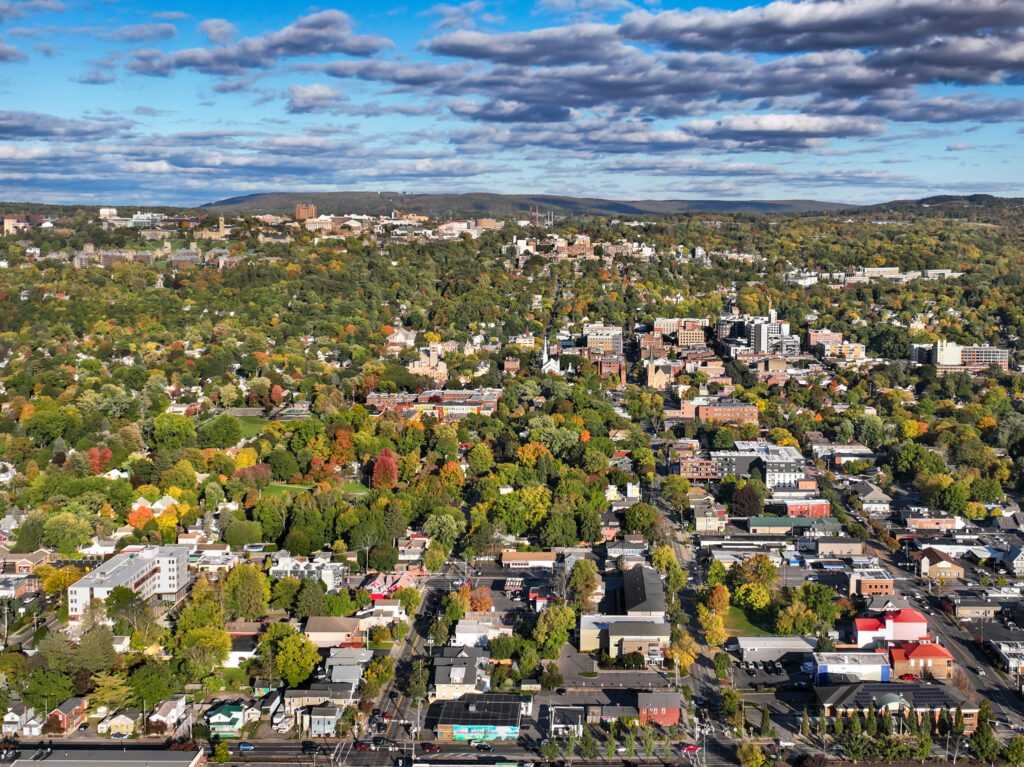At the tail end of January, the New York State Energy Research and Development Authority (NYSERDA) quietly released the Carbon Neutral Buildings Roadmap. This is the first report in its much anticipated series: “The Future of Buildings.” The Roadmap sets out an action plan for how the building sector will need to adapt and change in order to meet New York’s ambitious climate goals of reducing greenhouse gas emissions (GHG) by 85% by 2050. Unfortunately, much of the public spotlight is currently centered on Governor Hochul’s proposed statewide gas ban in new construction, resulting in limited awareness and discourse about the impact the Roadmap will have.
The majority of the Roadmap focuses on the climate-related impacts of the policy initiatives laid out by NYSERDA, and there will be plenty of analyses and debate around this by others in the climate space. I am keen to highlight a section of the report that I fear may not receive the attention it warrants: Chapter 10 “Equity and Decarbonizing Disadvantaged Communities”. This chapter shows that NYSERDA views decarbonizing buildings as not just a means of achieving NY’s climate goals, but as an opportunity to resolve historical injustices, reduce long-standing socioeconomic disparities across the state, and empower disadvantaged communities.

Affordability Considerations
NYSERDA sets out a three-part approach to center equity in building decarbonization for low- and moderate-income (LMI) housing and Disadvantaged Communities (DACs). The first area focuses on “Electrification While Preserving Affordability”, a complicated issue, without a one-size fits all solution. The report notes that “balancing a cautious approach to electrification in the short term, against the long-term costs of inaction, will be an integral part of New York’s path to equitable decarbonization.” IMT supports equitable building electrification policies and programs designed to reduce the energy burden of frontline communities and strengthen their resilience. All-electric new construction is low-hanging fruit and provides a particularly promising opportunity to lock in long-term affordability and energy savings.
The initiatives laid out in the electrification section are grounded in the knowledge that low-income households are much more sensitive to changes in monthly expenses compared to the general population, and so the impact a retrofit may have on operating costs is a crucial consideration. With this in mind, NYSERDA will initially focus electrification efforts on buildings that use oil, propane, or electric resistance heating, as conversions from these systems to heat pumps lead to more favorable economic outcomes. These efforts will be combined with energy efficiency measures, such as weatherization, to maximize the energy-cost savings in DACs (also improving the comfort of occupants and reducing the strain on the grid.) The Roadmap acknowledges the risk that as more buildings are electrified, the costs of maintaining the gas network will have to be shared amongst a smaller pool of users, most likely increasing energy cost burdens.
New York’s Financing Approach
The second part of the Roadmap approach is centered on “LMI & DAC Decarbonization Investments First”. At the most basic level, NY intends to increase the funds available to support those at risk. The Roadmap spells out that “by creating success stories and building confidence in decarbonization approaches in LMI housing and DACs, New York will drive market development and cost compression in decarbonization products and services statewide, ultimately benefiting all New Yorkers.” NY’s Climate Act sets a target of 40% of all clean energy investments, and a minimum of 35% of investments go to DACs. NY intends to quadruple the current spending levels which support efficiency and electrification programs that serve LMI households, affordable housing, public housing, and DACs, to a minimum of $1 billion a year.
A targeted example of this is the NYSERDA-backed solicitation for a Packaged Window Heat Pump to install in NYC Housing Authority properties, with the winning manufacturer receiving an order of 20,000-24,000 units. Such products can deliver efficient temperature control and are easily installed in existing properties, limiting resident disruption. NYSERDA is also collaborating with NY Homes and Community Renewal to finance solar, efficiency, and/or electrification in 10,000-15,000 units by investing $100 million through 2025, with programs targeting LMI housing. The Roadmap highlights how this approach will ensure DACs and residents of LMI housing benefit first from decarbonization efforts, and that the positive impacts will continue through to the state in general.

Combating Systemic Inequities
The final component of the Roadmap’s equity approach is “Place-Based & Community-Led Strategies for Long Term Benefits”. NYSERDA eloquently lays out this commitment as follows: “The path to equitable building decarbonization leads to a place where historically underserved stakeholders determine how the State supports decarbonization efforts in their communities. It also leads to a place where such communities have the opportunity for a literal equity stake in clean energy assets and businesses as a pathway to long term energy affordability and wealth building.” This is a commendable sentiment, but are there any policy actions laid out that will back up this goal? In a word, yes. The Regional Clean Energy Hubs initiative is a $53 million program to establish Clean Energy Hubs. These will provide community education, promoting public awareness about building decarbonization. These Hubs will afford opportunities for DACs to engage and be empowered to lead decarbonization efforts, through spreading awareness and increasing public understanding.
NYSERDA has also created the Energy Equity Collaborative, which is intended to be a consultative and planning body focused on environmental and climate justice issues. This places decision-making power in the hands of communities that will be impacted by decarbonization measures, and will allow them to use their lived experiences to tackle issues that are community priorities.
Finally, combining resources from both the health and energy sectors can increase funding opportunities and reach more households in DACs. The New York State Healthy Homes Value-Based Payment Pilot demonstrates a model for tackling health issues within the context of the buildings we live in. The Pilot’s residential healthy home intervention links energy efficiency & weatherization measures with environmental hazard mitigation, with an aim to address respiratory illnesses like asthma. The intervention includes home skilled nurse visits and community health worker support.
What’s Missing
Unfortunately, in terms of outlining a clear path for how NYSERDA will engage with DACs, the Roadmap lacks substance. The methods by which NY intends to improve DAC capacity are clear, the Clean Energy Hubs program outlined above is one example. But, there is limited explanation of how the state will reach out to DACs to begin working with them to implement policy objectives of the Roadmap. NYSERDA mentions the Energy Equity Collaborative, which will act as a planning and consultative body, but any fleshed out details of what this will entail are lacking in the Roadmap itself. There is some more information on this program on NYSERDA’s Energy & Climate Equity Strategy webpage, but this is not linked directly in the Roadmap.
In terms of any models that the Collaborative could follow, an approach similar to IMT’s Community Accountability Board (CAB) would lend itself to empowering DACs. A CAB is an advisory body tasked with reviewing the impact of building decarbonization policies on frontline communities and recommending programs, practices, and rules to reduce historical inequities. The CAB model places decision making power in a body with strong representation from community members that will be directly affected by the policy issue being addressed. It is not limited to building decarbonization, and could be a useful framework for the NYSERDA Collaborative to consider.

The Road Ahead for New York
NYSERDA has taken an important step towards reducing emissions in the NY’s built environment and mitigating the impacts of climate change. But, the aims of the Roadmap go beyond that, with a commendable (and much needed) level of focus being paid to ensure that building decarbonization efforts will benefit those that need it most. If successfully implemented, the Roadmap will not only help NY decarbonize its building sector, it will empower communities to advocate for themselves and begin a just transition of power. I applaud NYSERDA for the priority and attention that has been paid to ensuring that those New Yorkers that have been systematically and systemically excluded from the policy-making process can begin to be empowered and involved in decision making that affects them. The Roadmap goes a long way to address these historical injustices, and aims for the benefits of building decarbonization to flow first to those most in need.
This is an approach that IMT encourages other governments to learn from and replicate, in order to maximize community benefits and ensure frontline communities are not further harmed by the top-down approach to policy making that has been favored for the longest time. IMT will soon release our Community Engagement Framework. This resource provides a pathway for IMT, and other technical organizations, to do the work of equitable decarbonization through the co-development of energy efficiency and climate solutions that identify and address the challenges, priorities, and aspirations of frontline communities through meaningful community engagement.
However, there are unanswered questions on how NYSERDA plans to work with DACs to ensure implementation of the Roadmap addresses community priorities. This may be the subject of work that is yet to be published. If this is the case, NYSERDA may wish to present it in a form that shows how their engagement with communities will shift over time — a “roadmap” if you will.
